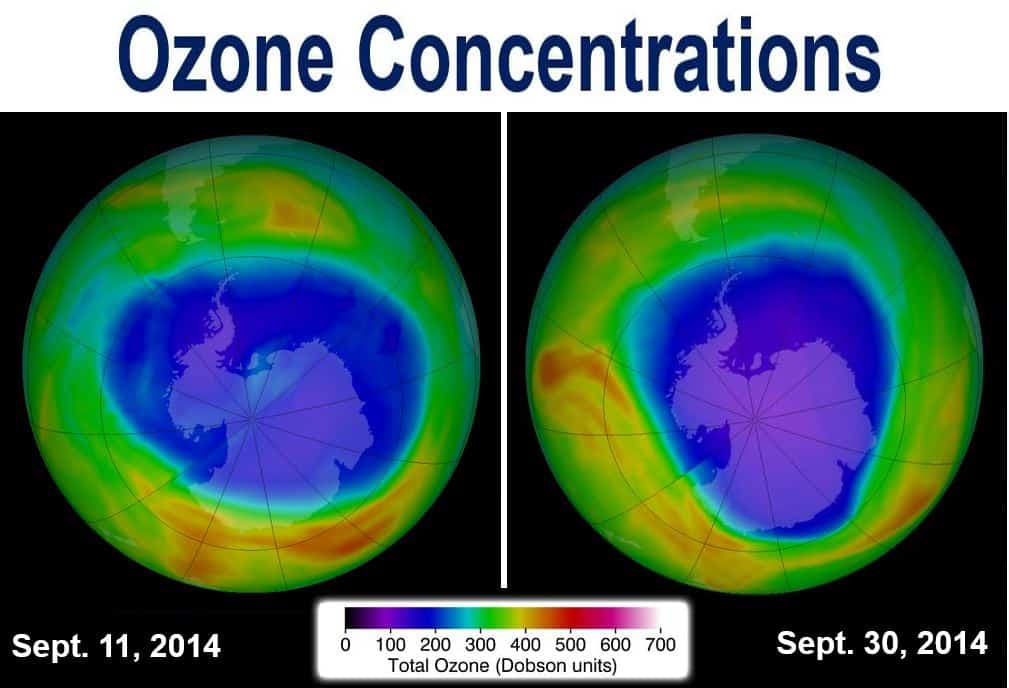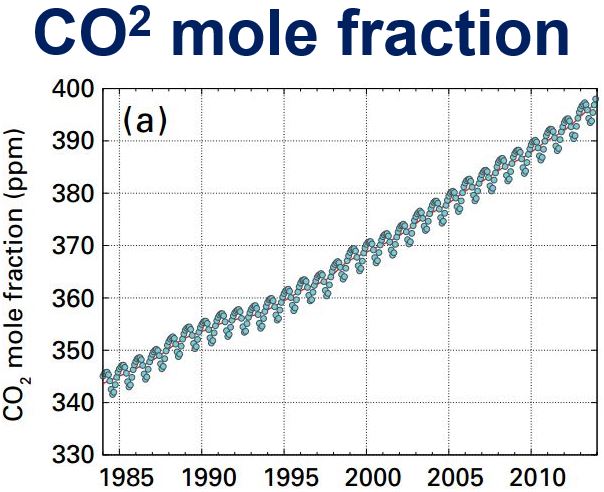This week has seen some encouraging news regarding the size of the ozone hole over Antarctica, which appears to be shrinking. However, the amount of greenhouses gases in our atmosphere reached a new record high in 2013, driven mainly by a surge in CO2 levels.
The Antarctic ozone hole reached its peak on 11 September, say scientists. This year’s hole was 9.2 million square miles (24.1m sq km), which is about the same size as the whole of North America.
According to scientists from NOAA (National Oceanic and Atmospheric Administration) and NASA, the single-day maximum area in 2014 was similar to that in the previous year, when it reached 24m sq km (9.3m sq m).

Ozone concentrations above Antarctica on Sept. 11 and Sept. 30, 2014. (Image: NASA)
The Antarctic ozone hole’s largest ever recorded size was 11.5m sq m (29.9m sq km) on 9 September, 2000.
Overall, the ozone hole in 2014 was smaller than the average over the 1998 to 2006 period, and was comparable to the dimensions recorded in 2010, 2012 and 2013.
The Antarctic ozone hole forms and expands in August and September, ever since higher atmospheric levels of chlorine increased in the 1980s.
The ozone layer protects us
The ozone layer, about 6.2 miles (10 km) up in the Earth’s atmosphere, which contains high concentration of ozone (03), absorbs most of the ultraviolet radiation from the Sun. This radiation can cause skin cancer and damage plants.
In 1987, the Montreal Protocol agreement regulated ozone-depleting substances, such as bromine-containing halons and chlorine-containing chlorofluorocarbons.
The level of these substances over Antarctica declined by 9% in 2014, compared to the 2000 peak.
Paul A. Newman, chief scientist for atmospheres at NASA’s Goddard Space Flight Center in Greenbelt, Maryland, said:
“Year-to-year weather variability significantly impacts Antarctica ozone because warmer stratospheric temperatures can reduce ozone depletion. The ozone hole area is smaller than what we saw in the late-1990s and early 2000s, and we know that chlorine levels are decreasing.”
“However, we are still uncertain about whether a long-term Antarctic stratospheric temperature warming might be reducing this ozone depletion.”
Researchers are currently trying to determine whether the ozone hole trend over the past ten years is a result of chlorine declines or temperature increases.
A rise in Antarctica’s stratospheric temperature would reduce the size of the ozone hole. Satellite and ground-based measurements indicate that chlorine levels are falling, but stratospheric temperature readings for that region are less reliable for determining long-term trends.
Researchers also found that the minimum thickness of the ozone layer in 2014 was 114 Dobson units on Sept 30, compared to 250 to 350 Dobson units in the 1960s.
NASA wrote:
“Over the last 50 years satellite and ground-based records over Antarctica show ozone column amounts ranging from 100 to 400 Dobson units, which translates to about 1 millimeter (1/25 inch) to 5 millimeters (1/6 inch) of ozone in a layer if all of the ozone were brought down to the surface.”
Surge in carbon dioxide concentrations
A significant rise in CO2 (carbon dioxide) levels pushed up greenhouse gas concentrations in the atmosphere to a new record high in 2013, according to the annual Greenhouse Gas Bulletin issued by the World Meteorological Organization (WMO).
The WMO says there is an urgent need to take action now to protect the planet from the potential devastation caused by climate change.
According to the Bulletin, between 1990 and 2013 there was a 34% rise in radiative forcing – the warming effect of our climate – due to long-lived greenhouse gases such as nitrous oxide, CO2 and methane.
Atmospheric CO2 concentrations in 2013 were 142% higher than in 1750, before the industrial revolution, while those of nitrous oxide and methane were 121% and 253% higher respectively.

Globally averaged CO2 mole fraction. (Image: www.wmo.int)
The WMO said that CO2 levels rose by more from 2012 to 2013 than during any other year since 1984. According to preliminary data, this could be related to reduced CO2 uptake by the Earth’s biosphere as well as steadily rising CO2 emissions.
WMO Secretary-General, Michel Jarraud, said:
“We know without any doubt that our climate is changing and our weather is becoming more extreme due to human activities such as the burning of fossil fuels. The Greenhouse Gas Bulletin shows that, far from falling, the concentration of carbon dioxide in the atmosphere actually increased last year at the fastest rate for nearly 30 years.”
“We must reverse this trend by cutting emissions of CO2 and other greenhouse gases across the board. We are running out of time. Carbon dioxide remains in the atmosphere for many hundreds of years and in the ocean for even longer.”
“Past, present and future CO2 emissions will have a cumulative impact on both global warming and ocean acidification. The laws of physics are non-negotiable. The Greenhouse Gas Bulletin provides a scientific base for decision-making.”
“We have the knowledge and we have the tools for action to try keep temperature increases within 2°C to give our planet a chance and to give our children and grandchildren a future. Pleading ignorance can no longer be an excuse for not acting.”

